We arrived in Rome the morning of October 16 after traveling for about 12 hours air time plus a couple of hours layover at the Atlanta airport between flights. Needless to say we were exhausted, but ready to take on Rome. We settled into the hotel that would be our home for the next five days, and in the afternoon met others who would be our traveling companions for the next three-and-a-half weeks of our trip. As with our other trip sites, place your mouse cursor over the photo for a description. I have also inserted links to some websites with more information and history should you desire to learn more. The links are underlined and if you click on them, they will take you to the website for that subject. Because of the extensive history of the areas we visited, I've used quite a few links.
Our first full day in Rome we were on our own to explore (and find the nearest ATM machine!) and we were given an orientation tour of the hotel area so we could find restaurants and the metro. 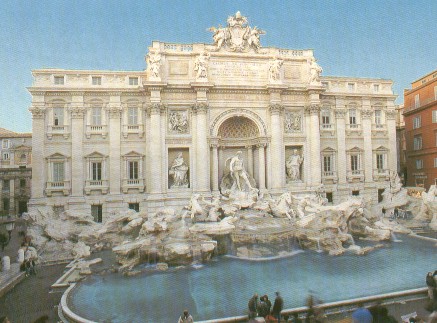 We took the metro to the Spanish Steps and from there walked to the Trevi Fountain. I threw in a coin and made a wish. Piazza di Spagna, or the Spanish Steps, were built to unite Via del Babuino (the easternmost of the three main arteries radiating into the city from the Piazza del Popolo) with Via Felice, the first great street planned by Sixtus V (1585). Located in the heart of Rome's historic center, the Trevi Fountain derives its name from its position at the intersection of three roads (tre vie). I've heard that the word "trivia" is derived from this, as people used to meet at the intersection of the three roads and catch up on the local news. It is one of the most photographed monuments in Rome, and many visitors agree that, among the many magnificent buildings of Baroque Rome, the Trevi Fountain is unrivaled as a spectacular aquatic structure. It is a poular meeting or gathering spot for Romans and vistors alike. The Trevi Fountain is located in the Trevi Square, within walking distance of the Spanish Steps and Piazza Navona. There has been a source of water at this site for over a thousand years. The central niche depicts Neptune,the sea god, riding a winged chariot driven by sea horses through the gushing waters from the Acqua Vergine aqueduct. The chariot is drawn by winged steeds and is led by a pair of tritons, the figures on the side represent good health and fertility. Legend has it that if you throw a coin into this fountain it guarantees your return to Rome. We had lunch al fresco before walking around and exploring more of Rome. In the evening we had a panoramic tour of Rome and dinner with our fellow travelers.
We took the metro to the Spanish Steps and from there walked to the Trevi Fountain. I threw in a coin and made a wish. Piazza di Spagna, or the Spanish Steps, were built to unite Via del Babuino (the easternmost of the three main arteries radiating into the city from the Piazza del Popolo) with Via Felice, the first great street planned by Sixtus V (1585). Located in the heart of Rome's historic center, the Trevi Fountain derives its name from its position at the intersection of three roads (tre vie). I've heard that the word "trivia" is derived from this, as people used to meet at the intersection of the three roads and catch up on the local news. It is one of the most photographed monuments in Rome, and many visitors agree that, among the many magnificent buildings of Baroque Rome, the Trevi Fountain is unrivaled as a spectacular aquatic structure. It is a poular meeting or gathering spot for Romans and vistors alike. The Trevi Fountain is located in the Trevi Square, within walking distance of the Spanish Steps and Piazza Navona. There has been a source of water at this site for over a thousand years. The central niche depicts Neptune,the sea god, riding a winged chariot driven by sea horses through the gushing waters from the Acqua Vergine aqueduct. The chariot is drawn by winged steeds and is led by a pair of tritons, the figures on the side represent good health and fertility. Legend has it that if you throw a coin into this fountain it guarantees your return to Rome. We had lunch al fresco before walking around and exploring more of Rome. In the evening we had a panoramic tour of Rome and dinner with our fellow travelers. 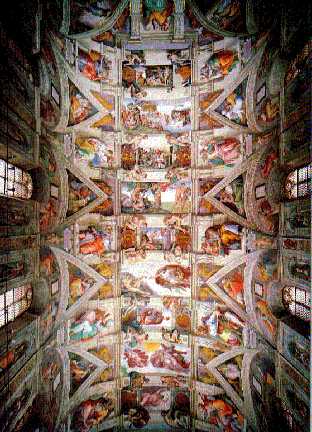
The next morning we had a tour of the Vatican, including the Sistine Chapel and St. Peter's Basilica. A picture can hardly do justice to the ceiling painted by Michaelangelo. The Vatican oversees a collection of churches, museums, palaces and galleries that house incredible treasures from around the world. There are paintings of great masters, ancient Egyptian artifacts, and Greek and Roman sculptures plus architectural masterpieces. We stood under Michaelangelo's magnificient frescoes on the ceiling of the Sistine Chapel; he worked four years to complete this project, and in November of 1999 a ten-year project of restoring and cleaning the ceiling was completed, revealing again the vital, vibrant colors Michelangelo first used. His story is told in the movie "The Agony and The Ecstasy".
In the afternoon we toured more of Rome with friends in our tour group, then went with them to dinner.... and do I mean dinner! We spent
FOUR HOURS grazing through a five-course dinner, not counting the bread or after-dinner liqueurs. In Europe you are charged for the bread, as it is not included with the meal. We never saw a menu; the chef/owner of the restaurant just kept bringing food. First was the appetizer - a basket of homemade sausages and cheeses, a bowl of olives, and fresh mozzarella served with crackers and bread plus a platter holding about a five-pound ham. 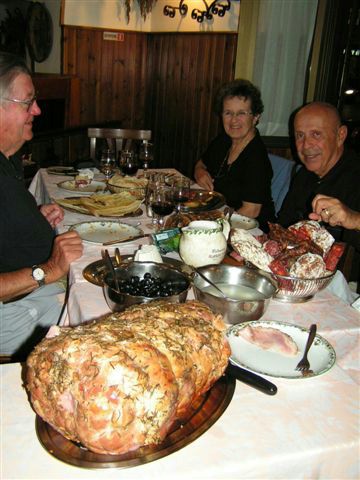 We were given a board and knife to just cut off what we wanted of the sausages, cheeses and ham. When we finished with that he brought the antipasto - seasoned and roasted onion slices, eggplant, roasted zucchini and peppers. About this time we mentioned that we were out of wine, since we had finished the liter pitcher he had brought us. The chef threw his hands to his head and said, "Mama mia! I bringa you more Italian a'Coca Cola!" Next was the pasta course - lasagna, spaghetti and ravioli. The chef then asked if we'd "like a little lamb". We asked for one portion for each couple to share, but it looked we all got a full portion of lamb, potatoes and salad. Needless to say, we were getting rather full, though given that we were eating over the course of a few hours, we were comfortable and having a wonderful time. We did discuss among the four of us, however, that we wondered what this extraordinary meal would cost us, not actually caring because we were having such a great evening. We also decided the chef was having a good time watching us enjoying it. Along with dessert came five bottles of after-dinner liqueurs, only one of which had a label, so we presumed, probably correctly, that the others were homemade. This was our first taste of Limoncello, a vibrant and tasty lemon-flavored liqueur. We actually made a batch of this after we returned home, since we were given recipes for it - none of them the same. When our kids were here we told them it was "Mom's Moonshine". It came out rather good. Another was a berry flavored liqueur made from a berry grown in Sardinia. There were two clear liqueurs, one which we are pretty sure was Grappa. We aren't sure to this day what the other was, but it was pretty potent. The last one we tried had a label. We of course had to ask for the check, which is the way it is in Europe, and a little after 10 p.m. we were presented with the bill - of only 65 Euros per couple.
We were given a board and knife to just cut off what we wanted of the sausages, cheeses and ham. When we finished with that he brought the antipasto - seasoned and roasted onion slices, eggplant, roasted zucchini and peppers. About this time we mentioned that we were out of wine, since we had finished the liter pitcher he had brought us. The chef threw his hands to his head and said, "Mama mia! I bringa you more Italian a'Coca Cola!" Next was the pasta course - lasagna, spaghetti and ravioli. The chef then asked if we'd "like a little lamb". We asked for one portion for each couple to share, but it looked we all got a full portion of lamb, potatoes and salad. Needless to say, we were getting rather full, though given that we were eating over the course of a few hours, we were comfortable and having a wonderful time. We did discuss among the four of us, however, that we wondered what this extraordinary meal would cost us, not actually caring because we were having such a great evening. We also decided the chef was having a good time watching us enjoying it. Along with dessert came five bottles of after-dinner liqueurs, only one of which had a label, so we presumed, probably correctly, that the others were homemade. This was our first taste of Limoncello, a vibrant and tasty lemon-flavored liqueur. We actually made a batch of this after we returned home, since we were given recipes for it - none of them the same. When our kids were here we told them it was "Mom's Moonshine". It came out rather good. Another was a berry flavored liqueur made from a berry grown in Sardinia. There were two clear liqueurs, one which we are pretty sure was Grappa. We aren't sure to this day what the other was, but it was pretty potent. The last one we tried had a label. We of course had to ask for the check, which is the way it is in Europe, and a little after 10 p.m. we were presented with the bill - of only 65 Euros per couple.
 That's about $75 U.S. We thought it a bargain, given all the food and the wonderful evening we had, including the anticipation of what our next course would be. We walked the few blocks back to the hotel sated and happy, talking about the wonderful evening we had experienced.
That's about $75 U.S. We thought it a bargain, given all the food and the wonderful evening we had, including the anticipation of what our next course would be. We walked the few blocks back to the hotel sated and happy, talking about the wonderful evening we had experienced.
The next day we had a tour of "Rome of the Caesars", which included the Roman Forum and Coliseum. The
Coliseum is only a shell of its former self, but remains the greatest architectural heritage from ancient Rome. It was in this massive structure, capable of holding 80,000 people, that the fabled and bloody gladiator combats took place. In the Middle Ages the structure was used as a fortress and later sustained damage from several earthquakes.
In the photo to the left is a Roman soldier talking on his cell phone outside
the Coliseum. The ancient Roman Forum was the political and commercial center of the city when Rome was at its greatest power. The Forum was constructed over 900 years with various emperors adding and extending temples, monuments, and buildings. Here is where the emperors, Roman senators, and consuls met to plan and pass the laws that governed Rome. As we walked out of the Forum area to meet our motorcoach we passed the entrance to the prison where the Apostles Paul and Peter were imprisoned.
Our last day in Rome we had a tour of more of the Eternal City. One of the things we visited was the Pantheon, the only domed building still standing from Ancient Roman times. The tomb of the great Renaissance Master Raphael is here. We also saw Caravaggio's paintings as well as the Moses, one of the most powerful statues carved by Michaelangelo. We also stopped at some of the famous piazzas (plazas) in Rome's historic center. Another tour some of us did was to the catacombs, layers beneath the current city, where many of the bodies had been buried
;-)
Late the next morning we boarded our motorcoach for our ride to the cliffside town of
Sorrento, located on the cliffs overlooking the Bay of Naples. It was here that the mythical Sirens, with the beauty of their sweet singing, much like Loreli on the Rhine River, lured sailors to shipwreck on the rocks. On the way we stopped at a cameo factory and an inlaid wood factory to marvel at the incredible skill of these artesians. 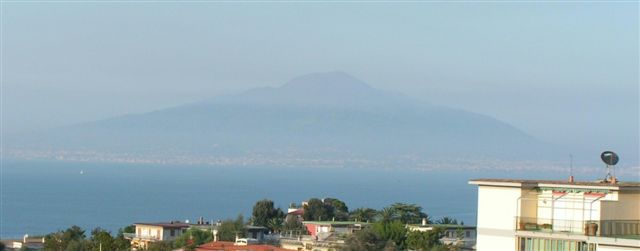 The next morning we had a lecture on speaking Italian - with and without words. The Italians have their own form of sign language, and we learned what and what not to use as hand motions. We then had a walking tour of Sorrento to learn the lay of the land and where the ATMs, restaurants, stores, and piazzas were. Sorrento is a wonderful town to walk around, and we really enjoyed our week there. We had lunch in a home and saw how the family lives. We noticed a definite change in the type of food in each region of Italy we visited. Here there was abundant fresh seafood to be had, as well as fresh ingredients from the markets. In Sorrento typical fare includes locally caught fish accompanied by homegrown vegetables such as eggplant, tomato and sweet peppers, and homemade pasta. In the afternoon we had a few hours to explore the town on our own. From our hotel room veranda we looked out across the Bay of Naples to a view of Mount Vesuvius. Later in the week we would get a much closer look at the mountain from Naples, Pompeii and Herculaneum.
The next morning we had a lecture on speaking Italian - with and without words. The Italians have their own form of sign language, and we learned what and what not to use as hand motions. We then had a walking tour of Sorrento to learn the lay of the land and where the ATMs, restaurants, stores, and piazzas were. Sorrento is a wonderful town to walk around, and we really enjoyed our week there. We had lunch in a home and saw how the family lives. We noticed a definite change in the type of food in each region of Italy we visited. Here there was abundant fresh seafood to be had, as well as fresh ingredients from the markets. In Sorrento typical fare includes locally caught fish accompanied by homegrown vegetables such as eggplant, tomato and sweet peppers, and homemade pasta. In the afternoon we had a few hours to explore the town on our own. From our hotel room veranda we looked out across the Bay of Naples to a view of Mount Vesuvius. Later in the week we would get a much closer look at the mountain from Naples, Pompeii and Herculaneum.
 After breakfast the next morning we set off on our motorcoach for a full day tour of the Amalfi Coast, which the locals refer to as "a gift of the Gods." We could easily see why! It is some of Italy's most beautiful coastline, rugged with rock formations overlooking fishing boats in the sea. Towns are built into the rocky cliffs, and we stopped at an overlook to the town of
Positano on the way to the town of Amalfi. During the Dark Ages the craft of paper making brought wealth to Amalfi. We had lunch at Scala on the winding road to the hilltop of Ravello, where the German composer Richard Wagner spent much of his time. Scala overlooks the Gulf of Salerno and the town of Amalfi nearly five miles directly below. We were all amazed at how well the driver maneuvered the touring coach around the hairpin turns. We returned to Sorrento after visiting the gardens of Villa Rufolo.
After breakfast the next morning we set off on our motorcoach for a full day tour of the Amalfi Coast, which the locals refer to as "a gift of the Gods." We could easily see why! It is some of Italy's most beautiful coastline, rugged with rock formations overlooking fishing boats in the sea. Towns are built into the rocky cliffs, and we stopped at an overlook to the town of
Positano on the way to the town of Amalfi. During the Dark Ages the craft of paper making brought wealth to Amalfi. We had lunch at Scala on the winding road to the hilltop of Ravello, where the German composer Richard Wagner spent much of his time. Scala overlooks the Gulf of Salerno and the town of Amalfi nearly five miles directly below. We were all amazed at how well the driver maneuvered the touring coach around the hairpin turns. We returned to Sorrento after visiting the gardens of Villa Rufolo.
We had free time in Sorrento during the week, so Jane found an Internet Cafe to check e-mail and see how family was doing. We also did some shopping, sightseeing, eating, shopping, eating...and more eating. 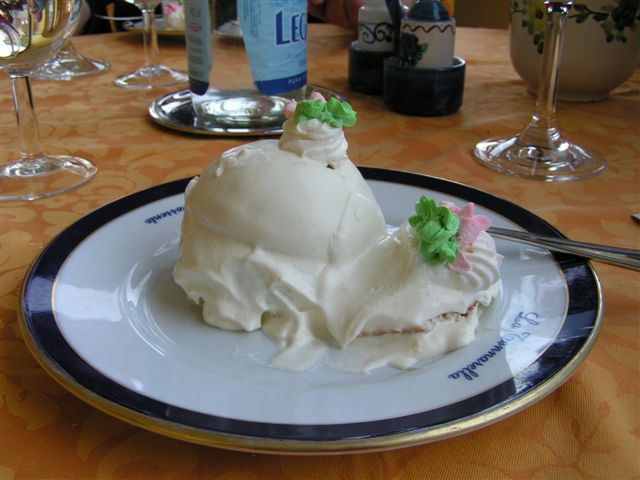 A friend of ours who owns an Italian restaurant in Prescott recommended we have lunch at the Hotel La Tonnarella, which
is on top of a hill at the end of town furthest from our hotel, so we rode the local bus, had lunch overlooking the bay, and walked the miles back to our hotel, hopefully walking off at least part of our lunch. The photo to the right is of our dessert, limoncello cake smothered with fresh whipped cream. The food in Sorrento was wonderful, and we enjoyed trying various restaurants. Our hotel was located just a few blocks from the main plaza, so we got a bit of exercise walking back and forth. On one of our "free days at camp" as Jane likes to call it, we went to the Isle of Capri, one of the most beautiful islands in the Mediterranean Sea. We saw the Gardens of Augustus from an overlook, and also went to Anacapri, the charming village high above the main port and resort that was once connected to Capri by the 800 steps of the Scala Fenicia (Phoenician Stairs).
A friend of ours who owns an Italian restaurant in Prescott recommended we have lunch at the Hotel La Tonnarella, which
is on top of a hill at the end of town furthest from our hotel, so we rode the local bus, had lunch overlooking the bay, and walked the miles back to our hotel, hopefully walking off at least part of our lunch. The photo to the right is of our dessert, limoncello cake smothered with fresh whipped cream. The food in Sorrento was wonderful, and we enjoyed trying various restaurants. Our hotel was located just a few blocks from the main plaza, so we got a bit of exercise walking back and forth. On one of our "free days at camp" as Jane likes to call it, we went to the Isle of Capri, one of the most beautiful islands in the Mediterranean Sea. We saw the Gardens of Augustus from an overlook, and also went to Anacapri, the charming village high above the main port and resort that was once connected to Capri by the 800 steps of the Scala Fenicia (Phoenician Stairs).  We walked around both areas of Capri and saw some breathtaking views from
Anacapri atop the island. When we were finished, we rode the finicula down to
Capri and boarded our jet boat back to Sorrento.
We walked around both areas of Capri and saw some breathtaking views from
Anacapri atop the island. When we were finished, we rode the finicula down to
Capri and boarded our jet boat back to Sorrento.
Naples, said to be where pizza originated, has been an important port since the city was first conquered by Rome in the fourth century B.C. It is one of the most beautiful seaports in the world, and the pizza is said to have originated in Naples. It is also the home of the great tenor, Enrico Caruso. Before our lunch of - you guessed it - pizza, we visited the National Archaeological Museum, which houses one of Europe's most valuable collections, featuring many treasures removed from long-buried Pompeii and Herculaneum. It's amazing how many things survived the eruption of Mount Vesuvius and were uncovered virtually intact.
Herculaneum is better preserved than Pompeii. It is the only archaeological site in Italy where the second floors of the ancient Roman houses can still be seen standing. Also, you can still see the original mosaic decorations in the town's thermal baths. Pompeii had a more animated environment in contrast to the more serene atmosphere of Herculaneum. Pompeii was totally buried by the eruption of Mount Vesuvius in A.D. 79 and not rediscovered until the 17th century. We saw archaeologists at work, still uncovering Pompeii. We had a guided walking tour of both Pompeii and Herculaneum, though on different days. One interesting fact we learned is that the people of Pompeii died from exposure to the lava produced by the eruption, whereas the people of Herculaneum were suffocated by ash and gasses.
The next day we rode our motorcoach north to the town of Montecatini, in the heart of Tuscany. It was a full day's ride with a stop at a gold factory to check out the Italian gold and how it's made into jewelry. After settling into our hotel we walked to Montecatini Alto, an old town on top of the hill where we found a medieval village complete with a bell tower, parish church, and fortress. In the morning we had an orientation walking tour of our hotel vicinity and heard about some of the historical background of the area. Montecatini is the spa area, and we toured one of the local very upscale spas. We had lunch in a local farmhouse, along with sampling some vintages from the family's vineyard.I think every town in Europe, no matter how small or large, has a church atop the tallest hill, which makes for a pretty healthy hike. After a good night's rest we left to spend the day at Pisa and Lucca. 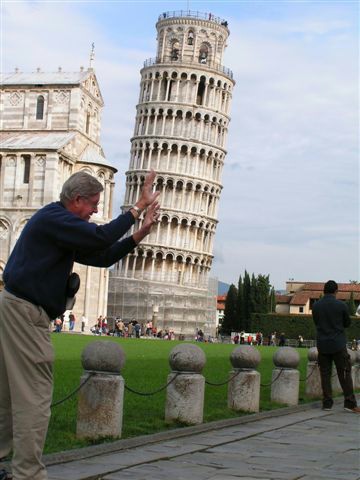
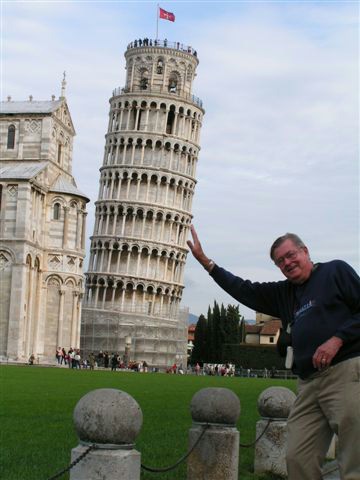 I guess Dale couldn't make up his mind whether to push the Tower over or hold it up.
I guess Dale couldn't make up his mind whether to push the Tower over or hold it up.
In Pisa we saw the "Square of Miracles", home to the cathedral and baptistry as well as the famous leaning tower, which reminded us of one of civilization's most illustrious names - Galileo Galilei, the genius who helped found modern science. He was born in Pisa and began his studies at the University of Pisa at the age of 17, and it is here that many of his greatest theories and inventions were born, including the telescope and the pendulum, which he reportedly used to demonstrate speed and velocity from atop the Pisa tower. As for the Tower of Pisa, it is the bell tower for the cathedral and construction began in 1173 and continued for about two hundred years. It began to tip even while being built, though the tilt was not part of the construction plans.
Lucca is a very unique and lovely city. It is the only Italian city that is totally enclosed, ringed by a high bulwark built between 1544 and 1645. What used to be a wide moat to help protect the town is now lush, green grass. The town became a Grand Duchy in the 19th century and was ruled by Elisa Baciocchi, the sister of Napoleon. The countryside around Lucca produces a high quality, world-famous olive oil, and another Lucca culinary delight is buccellato a sweet ring-shaped cake still made according to a 15th century recipe. We learned from our local tour guide that the Pisans and Luccans did not get along, and that's one reason the Luccans built the wall around their city. To this day they still do not like each other much; in fact, the tour guide mentioned that the Pisans can't even build a tower doesn't lean .... We returned to Montecatini in time for dinner - ahhhh...another lousy meal in Italy....don't let me fool you - we loved it all!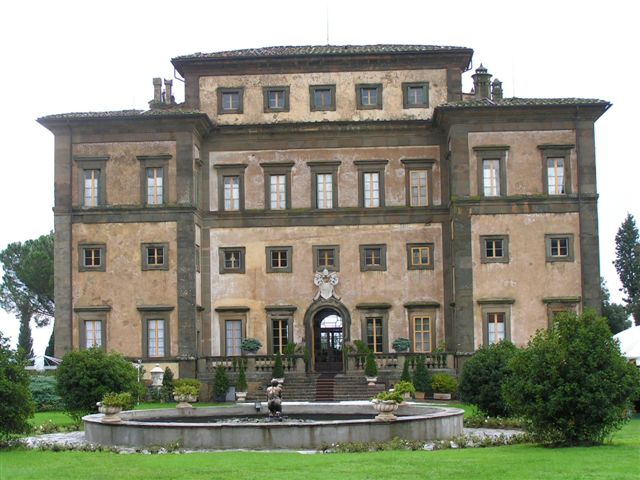
Every day was a new adventure. This day it was a ride through the Tuscan countryside to the town of Vinci, home of the great Renaissance genius, Leonardo. We visited his birthplace, a 15th century farmhouse surrounded by olive groves, and the medieval village of Vinci where we went to the fortified medieval tower housing the Leonardo Museum. After that we went to
Villa Rospigliosi, a Baroque villa in the area. It was commissioned in 1669 by the pope to artist and architect Bianlorenzo Bernini, creator of St. Peter's Square and Piazza Navona's fountains in Rome. The gardens were exquisite, and there was an old tree swing which some of us tried out. We had lunch here, preceded by wine and appetizers in the more than ample parlor. Lunch was a four-course extravaganza consisting of a large tray containing a jack-o-lantern (it was October 31st) and a whole roasted pig. It was really quite a show, and another wonderful four-course meal.
 The next day we saw more of the Tuscany countryside as we headed southwest out of Montecatini toward the medieval hill-town of San Gimignano, known as the Town of Towers. We rode past rolling hills covered by vineyards, remote medieval towns and sun-drenched castles. We made a stop at the
Florence American Cemetery where many of our soldiers are buried. It was awesome to see row after row of American flags here. From here we continued on to San Gimignano where we had time to walk the narrow, stone-paved streets of this quaint town and do some retail therapy. In the center of the square is a cistern from the year two. After we finished exploring the town we continued our journey on roads lined with elegant cypress trees, past endless stretches of grapevines and through Tuscany's Chianti country to our lunch destination,
Castle Oliveto, still a producer of wine and olive oil, and also now home to a retreat for travelers as well as a place for delicious dining and wedding festivities. We again had a wonderful four-course lunch.
The next day we saw more of the Tuscany countryside as we headed southwest out of Montecatini toward the medieval hill-town of San Gimignano, known as the Town of Towers. We rode past rolling hills covered by vineyards, remote medieval towns and sun-drenched castles. We made a stop at the
Florence American Cemetery where many of our soldiers are buried. It was awesome to see row after row of American flags here. From here we continued on to San Gimignano where we had time to walk the narrow, stone-paved streets of this quaint town and do some retail therapy. In the center of the square is a cistern from the year two. After we finished exploring the town we continued our journey on roads lined with elegant cypress trees, past endless stretches of grapevines and through Tuscany's Chianti country to our lunch destination,
Castle Oliveto, still a producer of wine and olive oil, and also now home to a retreat for travelers as well as a place for delicious dining and wedding festivities. We again had a wonderful four-course lunch. 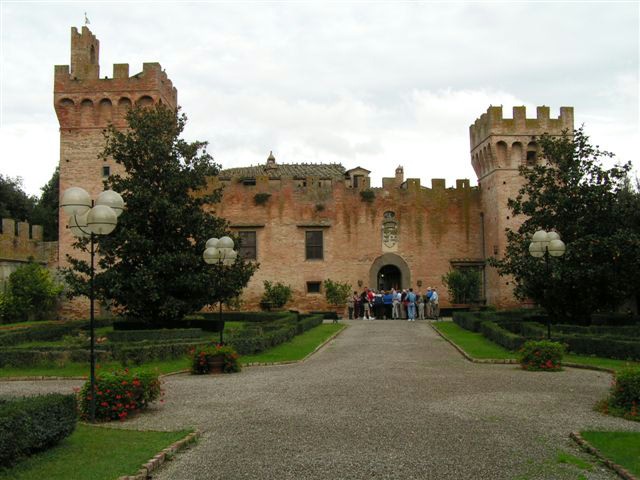 Later in the day we had a lecture on "The Art of the Renaissance" to prepare us for the next day in Florence.
Later in the day we had a lecture on "The Art of the Renaissance" to prepare us for the next day in Florence.
After breakfast the next morning we traveled into the heart of Tuscany to
Florence, center of the artistic genius of the Renaissance. Florence is on the banks of the Arno River and was a major commercial and cultural center during the 13th century when merchants and tradesmen organized guilds that commissioned works of art to adorn their churches and palaces. This revival of interest in art and architecture gave birth to the Italian Renaissance in the 15th century that completely changed the face of this Tuscan town. Florence was the fountainhead of the Renaissance, and it is through the great artists of Florence that we know this "rebirth" - Dante, Boccaccio, Fra Angelico, Donatello, Botticelli, and Leonardo da Vinci and Michelangelo. We had a walking tour of Florence in the morning, and after lunch we toured the Galeria dell'Academia where Michelangelo's Statue of David stands. David is 18 feet tall, carved out of one piece of marble Michelangelo found in a courtyard and asked permission to use, and he is magnificent! In the evening we enjoyed a lecture on wine and olive oil, two of Italy's defining passions.
The next day was another "free day at camp". We walked around Montecatini and did some shopping, and packed to leave the next day for Venice. In the evening there was a farewell dinner at the hotel and we said our goodbyes to those going home the next day, as not everyone was going on to Venice.
 We arrived in
Venice in the afternoon and watched our luggage being loaded onto a boat to be taken to our hotel. We boarded speed boats and were taken to our hotel on the far end of the Grand Canal. After settling into our hotel we walked with our local guide to learn the area's restaurants and sights. In the evening several of us boarded a vaparetto and rode the Grand Canal round trip. It was like a water fairyland with everything lit up around us, and we ladies thought it quite enchanting. The vaporetto stations are floating docks, made to rise and fall with the water level, and are always bouncing, so it is tricky to step from the moving station onto the bouncing vaporetto, especially if the water is a little rough. The next morning we boarded a speedboat and went on the lagoon to the island of Murano, home of the famous Venetian Glass Works. We toured one of the glass factories and were treated to a glass blowing demonstration. We are amazed at the craftsmanship of the artesians. The glass making of Venice was all
We arrived in
Venice in the afternoon and watched our luggage being loaded onto a boat to be taken to our hotel. We boarded speed boats and were taken to our hotel on the far end of the Grand Canal. After settling into our hotel we walked with our local guide to learn the area's restaurants and sights. In the evening several of us boarded a vaparetto and rode the Grand Canal round trip. It was like a water fairyland with everything lit up around us, and we ladies thought it quite enchanting. The vaporetto stations are floating docks, made to rise and fall with the water level, and are always bouncing, so it is tricky to step from the moving station onto the bouncing vaporetto, especially if the water is a little rough. The next morning we boarded a speedboat and went on the lagoon to the island of Murano, home of the famous Venetian Glass Works. We toured one of the glass factories and were treated to a glass blowing demonstration. We are amazed at the craftsmanship of the artesians. The glass making of Venice was all  moved to the island of Murano due to the fire danger of the dozens of glass-heating ovens. Of course, we toured the gift shop belonging to this factory. Since there are no cars in Venice, the gondolas were the only vehicles in traffic jams.
moved to the island of Murano due to the fire danger of the dozens of glass-heating ovens. Of course, we toured the gift shop belonging to this factory. Since there are no cars in Venice, the gondolas were the only vehicles in traffic jams.
In the evening, due to Jane's wonderful sense of direction, we literally
missed the boat to go to the gondola station to meet our group for a gondola
ride and dinner. However, we did see some of Venice we would not have otherwise
seen, since the vaporetto we rode went all around the inside and outside of the
Grand Canal. We shopped in the Rialto Bridge gift shops, had a gelato, went to
Harry's Bar where Ernest Hemingway, Truman Capote, Orson Wells and others used
to hang out, and we could barely get in the door it was so crowded, so we left.
We had dinner and walked to St. Mark's Square to listen to the music played
there every Saturday night outside many of the restaurants. The next day we took
a gondola ride, so Jane's trip was complete. We spent the day walking some of the sidewalks around the lagoon to see areas we had not had a chance to explore, found gift shops and a quaint little restaurant for lunch.
Below is a photo Jane took from the Rialto bridge at dusk, just as restaurant
and shop lights were coming on.

We reached the end of our three-and-a-half weeks in Italy and it was time to say goodbye to the friends we had made from all over the United States. We exchanged addresses, phone numbers, and e-mail addresses, and many of us have kept in touch, sharing pictures of each other that we had taken, promising to contact each other if ever in their "neck of the woods".
In the morning we had a 5:20 wake-up call, so we got up, dressed and
boarded speed boats that took us to the terminal, where we got on minibuses that
took us to the airport for our flights home. We were given box breakfasts due to
the early flight.
We arrived home safe, tired, and looking forward to our
next trip, which will be three days in Lucerne, Switzerland, two weeks on a
riverboat from Basel, Switzerland to Antwerp, and three days in Bruges with
Oregon friends we met on our France trip two-and-a-half years ago, plus a few
other couples, seventeen people in all.Click here
for our Italy photo album, or
here to return to Home Page
 We took the metro to the Spanish Steps and from there walked to the Trevi Fountain. I threw in a coin and made a wish. Piazza di Spagna, or the Spanish Steps, were built to unite Via del Babuino (the easternmost of the three main arteries radiating into the city from the Piazza del Popolo) with Via Felice, the first great street planned by Sixtus V (1585). Located in the heart of Rome's historic center, the Trevi Fountain derives its name from its position at the intersection of three roads (tre vie). I've heard that the word "trivia" is derived from this, as people used to meet at the intersection of the three roads and catch up on the local news. It is one of the most photographed monuments in Rome, and many visitors agree that, among the many magnificent buildings of Baroque Rome, the Trevi Fountain is unrivaled as a spectacular aquatic structure. It is a poular meeting or gathering spot for Romans and vistors alike. The Trevi Fountain is located in the Trevi Square, within walking distance of the Spanish Steps and Piazza Navona. There has been a source of water at this site for over a thousand years. The central niche depicts Neptune,the sea god, riding a winged chariot driven by sea horses through the gushing waters from the Acqua Vergine aqueduct. The chariot is drawn by winged steeds and is led by a pair of tritons, the figures on the side represent good health and fertility. Legend has it that if you throw a coin into this fountain it guarantees your return to Rome. We had lunch al fresco before walking around and exploring more of Rome. In the evening we had a panoramic tour of Rome and dinner with our fellow travelers.
We took the metro to the Spanish Steps and from there walked to the Trevi Fountain. I threw in a coin and made a wish. Piazza di Spagna, or the Spanish Steps, were built to unite Via del Babuino (the easternmost of the three main arteries radiating into the city from the Piazza del Popolo) with Via Felice, the first great street planned by Sixtus V (1585). Located in the heart of Rome's historic center, the Trevi Fountain derives its name from its position at the intersection of three roads (tre vie). I've heard that the word "trivia" is derived from this, as people used to meet at the intersection of the three roads and catch up on the local news. It is one of the most photographed monuments in Rome, and many visitors agree that, among the many magnificent buildings of Baroque Rome, the Trevi Fountain is unrivaled as a spectacular aquatic structure. It is a poular meeting or gathering spot for Romans and vistors alike. The Trevi Fountain is located in the Trevi Square, within walking distance of the Spanish Steps and Piazza Navona. There has been a source of water at this site for over a thousand years. The central niche depicts Neptune,the sea god, riding a winged chariot driven by sea horses through the gushing waters from the Acqua Vergine aqueduct. The chariot is drawn by winged steeds and is led by a pair of tritons, the figures on the side represent good health and fertility. Legend has it that if you throw a coin into this fountain it guarantees your return to Rome. We had lunch al fresco before walking around and exploring more of Rome. In the evening we had a panoramic tour of Rome and dinner with our fellow travelers. 

 We arrived in
Venice in the afternoon and watched our luggage being loaded onto a boat to be taken to our hotel. We boarded speed boats and were taken to our hotel on the far end of the Grand Canal. After settling into our hotel we walked with our local guide to learn the area's restaurants and sights. In the evening several of us boarded a vaparetto and rode the Grand Canal round trip. It was like a water fairyland with everything lit up around us, and we ladies thought it quite enchanting. The vaporetto stations are floating docks, made to rise and fall with the water level, and are always bouncing, so it is tricky to step from the moving station onto the bouncing vaporetto, especially if the water is a little rough. The next morning we boarded a speedboat and went on the lagoon to the island of Murano, home of the famous Venetian Glass Works. We toured one of the glass factories and were treated to a glass blowing demonstration. We are amazed at the craftsmanship of the artesians. The glass making of Venice was all
We arrived in
Venice in the afternoon and watched our luggage being loaded onto a boat to be taken to our hotel. We boarded speed boats and were taken to our hotel on the far end of the Grand Canal. After settling into our hotel we walked with our local guide to learn the area's restaurants and sights. In the evening several of us boarded a vaparetto and rode the Grand Canal round trip. It was like a water fairyland with everything lit up around us, and we ladies thought it quite enchanting. The vaporetto stations are floating docks, made to rise and fall with the water level, and are always bouncing, so it is tricky to step from the moving station onto the bouncing vaporetto, especially if the water is a little rough. The next morning we boarded a speedboat and went on the lagoon to the island of Murano, home of the famous Venetian Glass Works. We toured one of the glass factories and were treated to a glass blowing demonstration. We are amazed at the craftsmanship of the artesians. The glass making of Venice was all  moved to the island of Murano due to the fire danger of the dozens of glass-heating ovens. Of course, we toured the gift shop belonging to this factory. Since there are no cars in Venice, the gondolas were the only vehicles in traffic jams.
moved to the island of Murano due to the fire danger of the dozens of glass-heating ovens. Of course, we toured the gift shop belonging to this factory. Since there are no cars in Venice, the gondolas were the only vehicles in traffic jams.